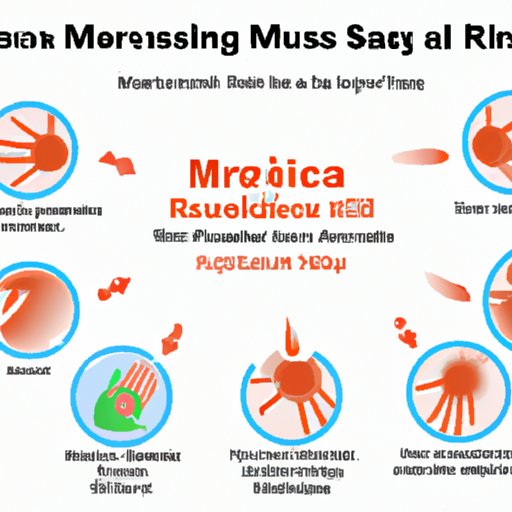
Introduction
Methicillin-resistant Staphylococcus aureus (MRSA) is a type of bacteria that is resistant to several antibiotics. It often causes skin infections that are difficult to treat, and in some cases, it can lead to serious complications. It is important to understand the symptoms of MRSA so that you can quickly identify it and prevent its spread. This article will provide an overview of MRSA symptoms, prevention, and treatment options.
Everything You Need to Know About MRSA Symptoms
Methicillin-resistant Staphylococcus aureus, commonly known as MRSA, is a type of staph infection that is resistant to several antibiotics. More specifically, MRSA is a strain of staph aureus that has acquired the ability to resist antibiotics like methicillin and oxacillin.
There are two main types of MRSA: healthcare-associated MRSA (HA-MRSA) and community-associated MRSA (CA-MRSA). HA-MRSA is usually found in hospitals, nursing homes, and other healthcare facilities. CA-MRSA is commonly found in schools, colleges, and other public places.
It is important to note that not all staph infections are MRSA. In fact, most staph infections are treatable with antibiotics.
MRSA spreads through contact with an infected person or contaminated surface. It can enter the body through cuts, abrasions, or other breaks in the skin.
Anyone can get MRSA, but some people are at a higher risk than others. These include:
- People who have weakened immune systems
- People who have chronic illnesses
- People who are hospitalized or live in long-term care facilities
- People who have had surgery or other invasive procedures
- Athletes who participate in contact sports

How to Identify MRSA Symptoms and Prevent Infection
The symptoms of MRSA can vary depending on the severity of the infection. It is important to be aware of the symptoms and risk factors so that you can quickly identify it and prevent it from spreading.
The symptoms of MRSA include:
- Red bumps on the skin that are painful, swollen, or warm to the touch
- Pus or other drainage from the bumps
- Fever
- Chills
- Sweating
To identify MRSA, a doctor may take a sample of the infected area and send it for testing. This will help determine if the infection is caused by MRSA or another type of bacteria.
Prevention of MRSA is key to avoiding the infection altogether. Good hygiene practices can go a long way in preventing the spread of MRSA. These include:
- Washing hands regularly with soap and water or using a hand sanitizer
- Covering cuts, abrasions, and wounds with a clean, dry bandage
- Avoiding contact with other people’s wounds or bandages
- Cleaning and disinfecting surfaces that may be contaminated with MRSA
MRSA Symptoms: What to Look For and When to See a Doctor
If you suspect that you might have MRSA, it is important to seek medical attention right away. Early diagnosis and treatment can help prevent the infection from spreading or becoming more serious.
To diagnose MRSA, a doctor may take a sample of the infected area and send it to a lab for testing. They may also ask about your symptoms and medical history.
The treatment for MRSA may include antibiotics, either oral or intravenous (IV). However, because MRSA is resistant to many antibiotics, it may be necessary to use stronger medications or a combination of antibiotics.
In some cases, the infection may require surgical drainage or removal of the infected tissue. This is particularly true if the infection is deep, large, or difficult to treat.
It is important to finish the entire course of antibiotics, even if your symptoms improve. This will help prevent the infection from returning and reduce the risk of antibiotic resistance.
It is also important to note that MRSA is highly contagious, and precautions should be taken to prevent the spread of the infection.
The Hidden Dangers of MRSA: Understanding the Symptoms
The symptoms of MRSA can range from mild skin infections to life-threatening complications. It is important to be aware of the severity of the infection and the potential complications that can arise.
Complications of MRSA can include:
- Sepsis, a life-threatening condition that occurs when the infection spreads through the bloodstream
- Pneumonia, which can cause cough, fever, and difficulty breathing
- Endocarditis, which is an infection of the heart valves
- Septic arthritis, which is an infection of the joints
Long-term effects of MRSA can also include scarring at the site of the infection. In some cases, the infection can lead to amputation of the affected limb or organ.
Vulnerable populations, such as the elderly or those with weakened immune systems, are at a higher risk of developing complications from MRSA.
MRSA Symptoms: A Comprehensive Guide for Diagnosis and Treatment
The diagnosis of MRSA often begins with a physical examination of the infected area. A doctor may also order a blood test or culture to confirm the diagnosis.
The treatment for MRSA may include antibiotics, surgical drainage, or a combination of both. Antibiotics are often the first line of defense, but stronger medications may be necessary if the infection is resistant to standard antibiotics.
It is important to take antibiotics exactly as prescribed and finish the entire course of medication. This will help prevent the infection from returning and reduce the risk of antibiotic resistance.
Patients with MRSA may require special care and precautions. Hospitals and other healthcare facilities often have strict protocols in place to prevent the spread of MRSA.
MRSA Symptoms: Protecting Yourself and Others from Deadly Infection
Prevention of MRSA is key to protecting yourself and others from the infection. Good hygiene practices can go a long way in preventing the spread of MRSA.
If you work in healthcare or other high-risk settings, it is important to follow all infection control protocols. This may include wearing gloves, gowns, or masks when necessary.
If you know someone who has MRSA, it is important to take precautions to prevent the spread of the infection. This may include avoiding contact with the infected area, washing your hands regularly, and cleaning and disinfecting surfaces that may be contaminated.
Education and awareness are also key to preventing the spread of MRSA. By understanding the symptoms and risk factors, you can take steps to avoid infection and help protect others.
Conclusion
Methicillin-resistant Staphylococcus aureus (MRSA) is a type of bacteria that is resistant to several antibiotics. It often causes skin infections that are difficult to treat, and in some cases, it can lead to serious complications. It is important to understand the symptoms of MRSA so that you can quickly identify it and prevent its spread. By following good hygiene practices and taking precautions to prevent infection, you can help protect yourself and others from this deadly infection.
For more information on MRSA symptoms and treatment, speak with your doctor or healthcare provider.




